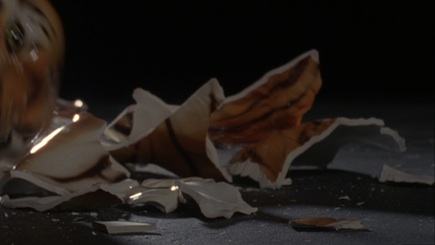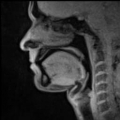You have no items in your cart. Want to get some nice things?
Go shopping
Beatrice Gibson’s The Tiger’s Mind is a film that explores voice, speech, representation, fiction and narrative. The film, shot in 16mm and transferred to High Definition, is built around Cornelius Cardew’s experimental score of the same name and is a montage of six improvised collaborations: experimental musician Alex Waterman as the Tree, artist Jesse Ash as the Wind, pianist John Tilbury as the Mind, research architect Celine Condorelli as the Tiger, artist Will Holder as Amy and Gibson herself as the Circle. Each participant developed different facets of the film (such as the props, Foley sound, music, special effects or set) which have subsequently been pieced together to create the whole.
The work is a fusion of forces—working forces, improvisational forces, creative forces and narrative forces—that culminate in a taut and thrilling exploration of the film’s score, its improvisational components and the narrative content as a whole. It is in fact remarkable to consider how all these tensions (process-based or fiction-based) could result in anything reflecting a coherent structure, a whole impression—but they do. In fact the result here is quite mesmerizing. The curatorial programme at the Showroom gallery adopts a unique strategy in commissioning art that brings together people and elements from otherwise disparate communities and fields to produce new work through open and discursive means. In this light, The Tiger’s Mind is very much a collaborative piece, both materially (the components of the film, sets, Foley sound), narratively (the characters) and in its varied and improvisational response to Cardew’s score. This minimal, avant-garde score takes on the production’s main structure, and as it plays on, each facet of the film operates as an improvisational element. Just as anyone who has ever spent hours jamming in a studio knows, the most exciting creations can come from unexpected relationships and dialogues between improvisers and their improvisations. A wealth of subjects are explored within and through this improv-collaborative structure and—despite the fact that simplistic analogies can never do any art justice—I cannot help but be reminded of a choir. As each voice comes in, a harmony is created, a harmony that is greater than the total of each participants’ individual contribution. Something special begins to emanate; amidst the cacophony something sublime is glimpsed or heard. Even as each character speaks, vying for primacy, the most intriguing and evocative exchanges occur between them.
Whilst watching and thinking, my understanding shifting variously within and between scenes, I found myself considering the idea of life-in-itself. As images of ominously solid hand guns dwell on table tops and brutalist architecture waits (or lurks) on a hill the question of the lives of things we don’t perceive comes to mind. How do we perceive what we cannot? What are their relations? What do they mean? How do they mean? These questions open up the possibility of new, exciting, and profound perceptions and are pursued by contemporary philosophers engaged with Speculative Realism. It is in this respect that I find Gibson’s exploration of collaborative and improvisational structures most exciting. By considering, for example, new, precarious possibilities for each ‘voice’ in the film (of the trees, or the wind), uncovering previously unseen subjectivities of supposedly inanimate objects or things, the potential for art and film to probe the meaning of objectivity is investigated in a most tangible, nuanced and poignant manner.
The film also creatively deconstructs speech and sound: the relationships that exist within a cacophony of speech, the re-stagings and “relocutions” of speech, the material, syllabic fragility of an utterance. Laughter and cries are heard, then looped and plunged into an altogether different meaning as a different voice references how annoying the other voice is. At one point the narrator’s voice is even pulled apart, breaking down into a staccato of syllabic fragments, “One. Sy. Ly. Bil. At. A. Time.”
One particular scene opens to a lounge. The camera then closes in on a gold foil curtain that crinkles in the wind, the sound of which increases and floods the space, producing a sharp and crisp static, like the image on screen; it bristles with potentiality, intensity and definition. In another scene, the camera wafts through an evergreen forest and comes upon an ominously stoic stack of speakers. There is an alien-like strangeness to the scene, with these speakers so obviously out of place in such an environment, but they are are not simply there, they in fact dominate the space, and like the Easter Island monoliths they exude an eerie potency. More than merely pointing to the ‘thereness’ of these objects, this film seeks to convey their very being.
As the camera approaches this speaker-mountain a cacophony of birdsong envelops the auditory stage, raising the question: where is this bird song coming from? Is it coming from the forest, or from the speakers? Or neither? Is this ambient sound the Foley sound? Or the sound of the set? Or of the props? As the camera drifts away, past the speakers, the viewer realizes that there are many voices in a film; and that ordinarily we are lead through a meticulously planned route that conceals some whilst amplifying others.
To revert back to my, perhaps overly simplistic, choir analogy, I found the speaker-mountain scene to be a microcosm of the film’s improv-collaborative structure. Comprised of a number of voices, throwing doubt over who or what has primacy, questions are raised and realisations unfold. As birdsong flies from prop to set to Foley sound, or as crunching gravel morphs from set to Foley sound, the collaborative and improvisational techniques of The Tiger’s Mind also deconstruct conventional film practices. Incorporating such complex layers of fragmented voices with improvised structures that explore the subjectivity of cinematic components (as well as the objects they depict), The Tiger’s Mind is not an “easy” film to watch. Indeed, the very premise of a deconstructed film that seeks new conceptual relationships between the component parts of cinema may be considered difficult viewing for anyone unfamiliar with contemporary artist’s films. But the film is all the more enthralling for the viewer because of its explorations of, and experimentations with, traditional cinematic constructs. It is an abstract thriller that is—on a level of conventional film appreciation—gripping and beautiful. The scene of the porcelain tiger shattering is a particularly wonderful cinematic moment. The 5.1 soundtrack has been effectively produced, conjuring an expansive soundscape, and the cinematographic aesthetics are richly nuanced.

The Tiger’s Mind is an artistic example of how cinema can explore new territories when it operates outside of conventions. The question of the relationship between Foley (post-production) sounds and the writer is not something that can be simply recorded or depicted in any traditional sense. Likewise, the task of unravelling the structures of narrative subjects and their relation to the viewer calls for a conceptual framework autonomous from traditional cinematic constructs. The Tiger’s Mind is a collaborative expedition that sets out to explore all these questions but, crucially, also presents them for the viewer. The foundational elements of film are explored and questioned but not to such a degree that the bridge to engaging and communicating with the viewer has disintegrated. If the task of contemporary artist’s film is to discover new modes of enquiry and creative ways to explore the limits of their material—while communicating this to a viewer—then Gibson’s The Tiger’s Mind is an accomplished piece.
The Tiger’s Mind is showing till 12 January 2012 at the Showroom Gallery in London. Watch the trailer here.

About Tristam Vivian Adams
Tristam Vivian Adams is currently studying at Goldsmiths College. He blogs at notesfromthevomitorium.blogspot.co.uk.




